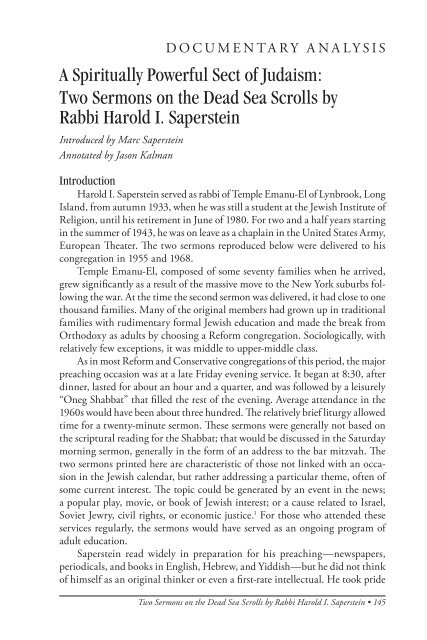The American Jewish Archives Journal, Volume LXI 2009, Number 1
The American Jewish Archives Journal, Volume LXI 2009, Number 1
The American Jewish Archives Journal, Volume LXI 2009, Number 1
Create successful ePaper yourself
Turn your PDF publications into a flip-book with our unique Google optimized e-Paper software.
DOCUMENTARY ANALYSIS<br />
A Spiritually Powerful Sect of Judaism:<br />
Two Sermons on the Dead Sea Scrolls by<br />
Rabbi Harold I. Saperstein<br />
Introduced by Marc Saperstein<br />
Annotated by Jason Kalman<br />
Introduction<br />
Harold I. Saperstein served as rabbi of Temple Emanu-El of Lynbrook, Long<br />
Island, from autumn 1933, when he was still a student at the <strong>Jewish</strong> Institute of<br />
Religion, until his retirement in June of 1980. For two and a half years starting<br />
in the summer of 1943, he was on leave as a chaplain in the United States Army,<br />
European <strong>The</strong>ater. <strong>The</strong> two sermons reproduced below were delivered to his<br />
congregation in 1955 and 1968.<br />
Temple Emanu-El, composed of some seventy families when he arrived,<br />
grew significantly as a result of the massive move to the New York suburbs following<br />
the war. At the time the second sermon was delivered, it had close to one<br />
thousand families. Many of the original members had grown up in traditional<br />
families with rudimentary formal <strong>Jewish</strong> education and made the break from<br />
Orthodoxy as adults by choosing a Reform congregation. Sociologically, with<br />
relatively few exceptions, it was middle to upper-middle class.<br />
As in most Reform and Conservative congregations of this period, the major<br />
preaching occasion was at a late Friday evening service. It began at 8:30, after<br />
dinner, lasted for about an hour and a quarter, and was followed by a leisurely<br />
“Oneg Shabbat” that filled the rest of the evening. Average attendance in the<br />
1960s would have been about three hundred. <strong>The</strong> relatively brief liturgy allowed<br />
time for a twenty-minute sermon. <strong>The</strong>se sermons were generally not based on<br />
the scriptural reading for the Shabbat; that would be discussed in the Saturday<br />
morning sermon, generally in the form of an address to the bar mitzvah. <strong>The</strong><br />
two sermons printed here are characteristic of those not linked with an occasion<br />
in the <strong>Jewish</strong> calendar, but rather addressing a particular theme, often of<br />
some current interest. <strong>The</strong> topic could be generated by an event in the news;<br />
a popular play, movie, or book of <strong>Jewish</strong> interest; or a cause related to Israel,<br />
Soviet Jewry, civil rights, or economic justice. 1 For those who attended these<br />
services regularly, the sermons would have served as an ongoing program of<br />
adult education.<br />
Saperstein read widely in preparation for his preaching—newspapers,<br />
periodicals, and books in English, Hebrew, and Yiddish—but he did not think<br />
of himself as an original thinker or even a first-rate intellectual. He took pride<br />
Two Sermons on the Dead Sea Scrolls by Rabbi Harold I. Saperstein • 145

















